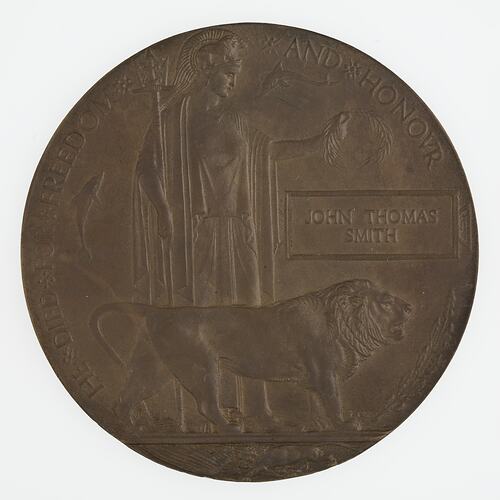Summary
Alternative Name(s): Death Plaque, The King's Penny, Dead Man's Penny
The bronze plaque, known colloquially as 'Dead Man's Penny', given by King George V to the next-of-kin of servicemen who died during World War I.
Next of Kin Memorial Plaque - World War I. In memory of John Thomas Smith.
Physical Description
A circular bronze plaque. It features Britannia, classically robed and helmeted, standing facing right, holding a modest laurel wreath crown in her extended left hand and supporting a trident by her right side with her right arm and hand. In the foreground a male lion stands facing right; the animal was originally described as 'striding forward in a menacing attitude' which may explain its unusually low profile. Above the lion's head is a rectangular panel containing the name of the deceased, JOHN THOMAS SMITH. To the right of Britannia's head and by the side of her right arm is a small dolphin, a reference to British sea-power. At the lower right edge is a branch of oak leaves and acorns. Around the edge, HE + DIED + FOR + FREEDOM + + AND + HONOUR. In exergue, in symbolic confrontation, a lion pounces on an eagle: a reference to the desired destruction of the Central Powers. The artist. E. Carter Preston's initials, ECRP, were embossed above the lion's right forepaw and the number "42" (possibly a Ministry of Munitions factory number) is impressed by the animal's right rear paw.
Obverse Description
Britannia, classically robed and helmeted, standing facing right, holding a modest laurel wreath crown in her extended left hand and supporting a trident by her right side with her right arm and hand. In the foreground a male lion stands facing right; the animal was originally described as 'striding forward in a menacing attitude' which may explain its unusually low profile. Above the lion's head is a rectangular panel containing the name of the deceased, JOHN THOMAS SMITH. To the right of Britannia's head and by the side of her right arm is a small dolphin, a reference to British sea-power. At the lower right edge is a branch of oak leaves and acorns. Around the edge, HE+DIED+FOR+FREEDOM+ +AND+HONOUR. In exergue, in symbolic confrontation, a lion pounces on an eagle: a reference to the desired destruction of the Central Powers. The artist, E. Carter Preston's initials were embossed above the lion's right forepaw and the number "42" (possibly a Ministry of Munitions factory number) is impressed by the animal's right rear paw.
Reverse Description
Plain
Edge Description
Plain
Significance
Memorial plaques of this sort were devised by the British government during World War I to commemorate the fallen and boost lagging morale. In 1916 a committee was established by Secretary of State for War, David Lloyd George, to consider what form the memorial should take for those who died 'on active service'. The Committee included two peers, six Members of Parliament, and representatives for the Dominions, the India Office, the Colonial Office and the Admiralty. A specialist sub-committee assisted with artistic and technical detail, and included the directors of the National Gallery and the Victoria and Albert Museum, and the Keeper of the Department of Coins and Medals at the British Museum.
In August 1917 a public design competition was advertised, with a £500 prize pool. Entrants were advised that 'The design should comprehend a subject and a brief inscription. It is suggested that some symbolical figure subject should be chosen but the following inscription has been decided upon: 'HE DIED FOR FREEDOM AND HONOUR' and this must form part of the design.' A space for the deceased's name was to be included. It was later decided that a scroll would also be presented. Over 800 entries were received from Britain and beyond. The first prize, of £250, for two model designs, was awarded on 24 January 1918 to Edward Carter Preston, Sandon Studios Society, Liverpool. The lion in his depiction was originally 'striding forward in a menacing attitude' but was later given a more benign posture.
Production of the plaques began in December 1918, but had a troubled history. The plaques were first made in London's 'Memorial Plaque Factory' managed by American engineer and entrepreneur Manning Pike, then his monopoly was terminated and the plaques began to be made Woolwich Arsenal and other former munitions factories. Production was finally was placed back in the hands of Pike, by which time standards had declined. It is estimated that about 1,150,000 specimens were made.
The plaques commemorated those men and women who died between 4 August 1914 and 10 January 1920, for Home Establishments, Western Europe and the Dominions. Deaths in other theatres of war (including Russia) or for those who died subsequently was 30 April 1920.
More Information
-
Collecting Areas
-
Date Issued
1919 AD
-
Issued By
-
Artist
Edward C. Preston - Sandon Studios Society, England, Great Britain
-
Person Named
-
Inscriptions
JOHN THOMAS SMITH HE DIED FOR FREEDOM AND HONOUR
-
Material
Bronze
-
Classification
-
Category
-
Discipline
-
Type of item
-
Overall Dimensions
120 mm (Outside Diameter)
120 mm diameter.
-
Shape
Round
-
References
References: From National Archives of Australia; B2455 World War One service records: [Link 1] 'The Next of Kin Memorial Plaque', Imperial War Museum website: [Link 2] accessed March 2009.
-
Keywords
